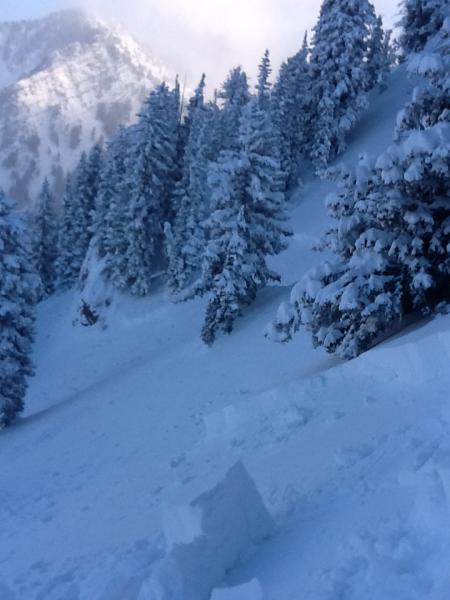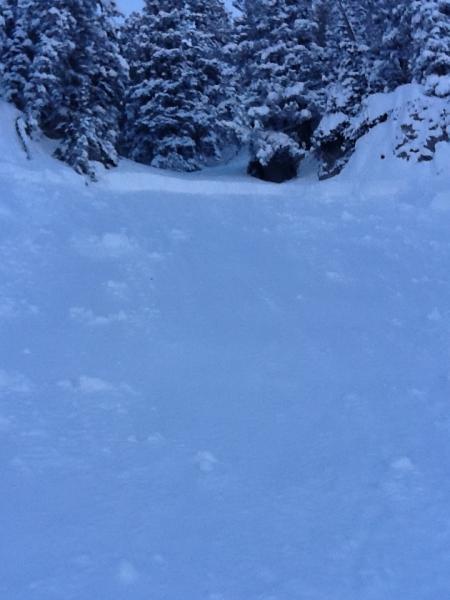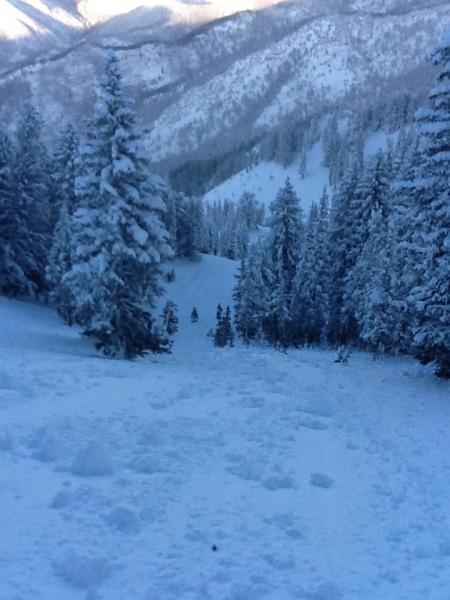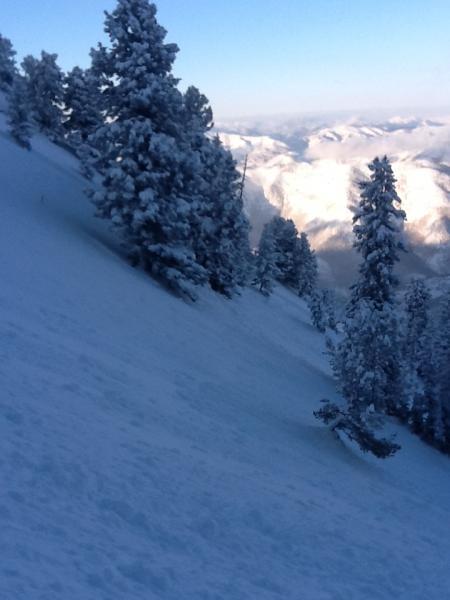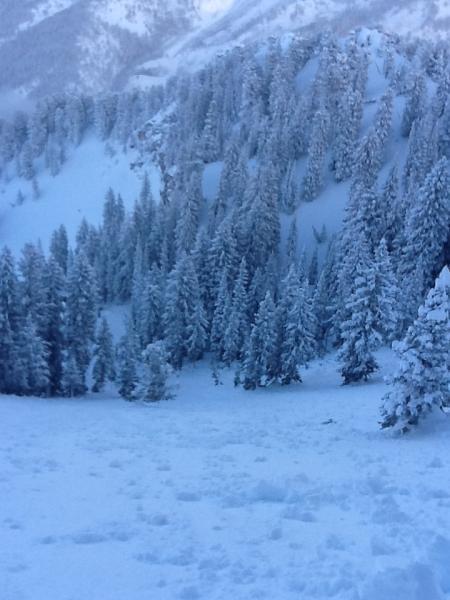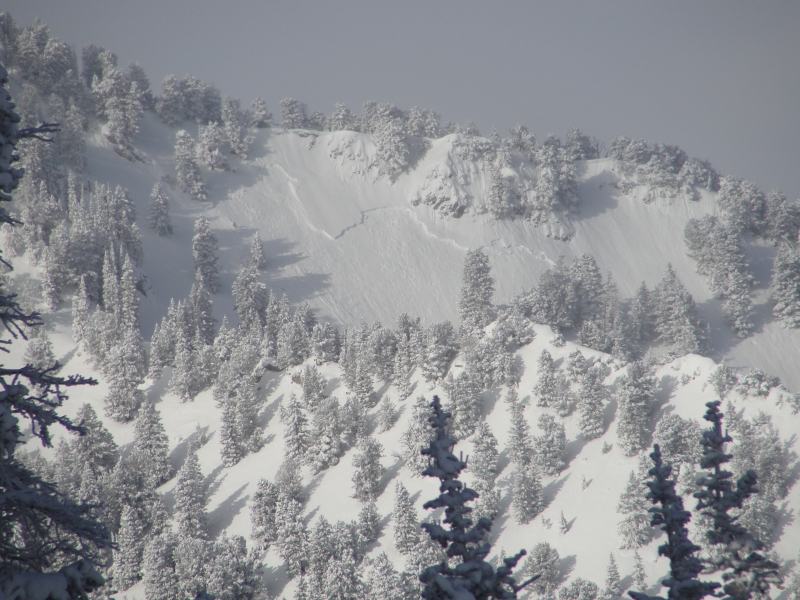First off, I'd like to thank Skier A for having a candid conversation with me about this incident. This is an incident that could happen to any of us who seek the deep powder. It is easy to look back in hindsight and point out the mistakes but I'd like to point out, as you'll see, how Skier A performed a flawless rescue effort after the incident had taken place and was also able to humbly admit that the draw of the deep snow was what over-rode their better judgement.
Two skiers, Skier A (male 30 years old) and Skier B (female 43 years old) were going ski touring in Porter Fork of Mill Creek Canyon. Skier A has around 7 years of backcountry experience and has taken an avalanche course and Skier B had gone into the backcountry sporadically for years and had been getting more enthusiastic about it over the last couple. They regularly read the local avalanche advisory and were aware of what conditions were present and what to expect during the day. They both were carrying all of the proper avalanche safety equipment.
They ascended Porter Fork and decided to go into West Porter Fork. They were around half way up and were finding instability within the new snow by doing quick hand pits along the way. Their intention was to gain the more low angled slope to the saddle. They were sticking to a treed sub-ridge. As they approached a decision making point, the lure of a better powder run clouded their judgement. They devieated from their plan and started to ascend a steeper portion of the slope perhaps not intending to go very high. They didn't make it too far when Skier A who was out in the lead felt a large collapse and saw the slope high above start to crack and open up. They both new what was happening and turned their skis downhill for a quick moment before the massive avalanche overtook them.
Skier A reports being thrown head first downhill and going for a violent ride before miraculously getting snagged in some trees and having the avalanche mostly wash over him. The avalanche stopped and Skier B was not visible. Skier A freaked out for a moment and then took a second to compose himself. This was a very good move as he was able to start thinking clearly and remembered his training with the rescue equipment. He switched his avalanche beacon to "receive" mode and immediately picked up a signal. He reported that he easily pinpointed his partner after a very short period of time and was able to dig her out from under one to two feet of snow. She started to breath laboriously and then QUIT BREATHING!! Skier A then completely extricated her from the hole and started rescue breathing on her. After a number of breaths she started labored breathing again and slowly came back to conscience. She had lost a glove and a ski boot not to mention her skis. Skier A started getting all of their extra clothing on her and wrapped her foot with a down jacket and a plastic bag. At this time, another lone skier who was descending the avalanche path stumbled across them and started to assist with rescue efforts. Skier B was able to regain enough composure to start to descend the slope with assistance. A call to 911 was made and a helicopter was dispatched which eventually located the party and evacuated them. Skier B sustained frostbite on her hand and foot but it appears no other trauma was sustained.
The following was reported by Brandon Dodge who leads the snow safety at Brighton Ski Resort and is heavily involved with Wasatch Backcountry Rescue:
I am sure other details and reports will come together about this incident, but I wanted to give my two cents. This is a perfect example of the tremendous rescue community and resources we have available and working together in the Wasatch. Unified Police Dept received a report of an avalanche with a full burial, injuries and loss of equipment in Porter Fork of Millcreek Canyon. Salt Lake County search and Rescue was activated as was WBR (Wasatch Backcountry Rescue) at 540 pm. SAR team members responded to Porter Fork and began a ground assault towards the victims with snowmobiles and skiers. The Dept of Public Safety (Utah Highway Patrol) helicopter was called out to shuttle WBR members to the scene. The DPS helicopter picked up two members of WBR at Brighton Resort and shuttled them to the scene. The patient was assessed and both victims were loaded into the helicopter and flown to waiting EMS crews in Millcreek canyon (Unified Fire). The DPS helicopter returned to pick up WBR members and return them to Brighton. The WBR members were back on the ground and the SAR teams returned to Incident Command by 850 pm. My hat is off to the incredible rescue system, forward thinking incident commanders and volunteer rescuers we have in the Wasatch. This rescue involved 6 agencies and was handled with perfection. VECC (Valley Emergency Call Center) received the call and promptly notified Unified Police Dept and Unified Fire Authority. Salt Lake County SAR, The Dept of Public Safety and WBR all were called out to assist. It going pretty much goes without saying that victims of such a traumatic incident, injured, deep in the backcountry and without the gear and assistance to self-rescue would most likely not survive the -10 or lower temps of Saturday night.
A lone skier (happened to be a friend or ours at the UAC) stumbled onto the avalanche as he was walking the ridgeline and sent us this account as well as some photos:
Started the day in Thaynes w two runs. Tough deep trail breaking. Noted collapsing on ascent. Decided to finish the day by summiting Porter Peak, via the ridge route separating West Porter and Thaynes. Noted collapsing on ascent. On approach to Porter Peak observed east facing bowl beneath Porter Peak had avalanched. Decided bed surface would be safe descent. Took several photos. Sun was low, about 4:30 pm, decided to exit West Porter. Came across person A. A informed he and his partner person B had trigger the avalanche while ascending bowl. A had lost a pole. B had lost both poles, both skis, and a boot. A and I fashioned a boot for B with a down jacket and skin bag, secured w two voile straps. B had a cell phone so I told A to call 911. At this time it is 5pm. The three of us begin to descend, A and I assisting B. An hour passes, it is dark and a helicopter flys by us, just like in the movies, it doesn't see us. We agree I will leave A and B to notify search and rescue where A and B are. I descend West Porter to the Porter Fork road and meet search and rescue. After talking w them for a few minutes the helicopter locates A and B and they are safely extracted, according to the last information I had.
Note: Although this may not make sense to people with little avalanche experience, It is often a safe and common practice to descend an avalanche path that has recently avalanched which is what our friend was doing, using the avalanche path as a safe exit from Porter Fork.
This avalanche path is an east northeast facing path with a starting zone at about 9400' and is around 40 degrees in steepness. The avalanche was measured at 700 feet wide and ran just over 800 feet vertical distance and had a crown face that averaged 2 feet deep. The starting zone is 40 degrees. The avalanche was triggered from lower on the slope where the slope angle is less. Photo thanks to Michael Junulaitis.
Two weeks of cold dry weather prior to the accident contributed to the surface of the snow becoming very weak through the "near surface faceting" process where the surface snow basically turns into a weak and "sugary" snow grains. A rime crust capped off these facets. A somewhat unusual snow storm produced large amounts of snow in areas that don't usually see all that much coupled with moderate wind speeds with stronger gusts which helped form the "slab" on top of the rime crust and weak snow beneath. There was not quite enough snow to produce a natural avalanche cycle but the conditions were pushed to the point where all that was needed was some humans to prod at it a bit to produce avalanches.
Below is a picture of the faceted weak layer which was between "fist" and a "four finger" hand hardness. The slab itself was a "four finger" plus layer of snow with low density snow on the surface.

